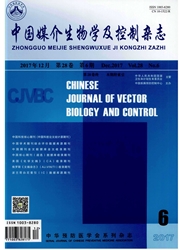

 中文摘要:
中文摘要:
目的通过对我国西南3省交界处静息鼠疫疫源地连续3年的监测,了解当地鼠疫流行情况并验证鼠疫耶尔森菌(鼠疫菌)内在保存学说的正确性。方法于2013-2015年对曾发生过人间鼠疫疫情的贵州省兴义市、广西壮族自治区西林和隆林县、云南省罗平县开展啮齿动物及指示动物的鼠疫菌病原学及血清学检测,并对其他致病性耶尔森菌开展病原学检测;对与疫区县所属同一省份的非疫区开展动物间其他致病性耶尔森菌的对照检测;对非疫区≤5岁的腹泻儿童开展其他致病性耶尔森菌的病原学调查。结果静息鼠疫疫源地仍存在F1抗体阳性的啮齿动物和指示动物;疫区与非疫区动物均检出小肠结肠炎耶尔森菌(疫区啮齿动物、犬、家猪的分离率分别为0.80%、1.55%和3.59%,非疫区犬和家猪的分离率分别为3.86%和12.71%),在非疫区致病性菌株的分离率更高(疫区犬和家猪的分离率为0.39%和3.19%,非疫区犬和家猪的分离率为1.19%和7.43%);假结核耶尔森菌仅分离自非疫区。此外,在非疫区≤5岁腹泻儿童中致病性小肠结肠炎耶尔森菌的感染率达0.64%。结论静息期内在宿主动物中仍存在鼠疫菌的循环,证实了鼠疫菌内在保存学说的正确性。在静息期疫源地内,宿主动物携带致病性小肠结肠炎耶尔森菌的能力弱于同省非疫源地的宿主动物,佐证了致病性耶尔森菌的交叉免疫学说。
 英文摘要:
英文摘要:
Objective Through intensive surveillance of three years in a row, Yersinia pestis was found within the focus, which highly supports the inner preservation theory of plague. Methods From 2013 to 2015 in four plague foci where the outbreak took place, Xingyi county in Guizhou province, Xilin and Longlin counties in Guangxi Zhuang Autonomous Region and Luoping county in Yunnan province, samples of rodents were examined for Y. pestis, serum detection of rodent hosts and indicator animals were tested for F1 antibody; samples of rodents, dogs and pigs were isolated for Y. enterocolitica and Y. pseudotuberculosis. Pig and dog samples from plague free area in Guangxi and Guizhou provinces were also examined for Y. enterocolitica and Y. pseudotuberculosis. Diarrhea children ≤5 years old were surveyed for these two enteropathogens in plague free area of Guangxi. Results Rodents and indicator animals were found carrying the F1 antibody in natural plague foci during rest period. The isolation rate of Y. enterocolitica in animals of natural plague foci was 0.80%, 1.55% and 3.59% for rodents, dogs and pigs, the rate in plague free region was 3.86% and 12.71% for dogs and pigs. For pathogenic strains, it was 0.39% and 3.19% for dogs and pigs in natural plague foci, 1.19% and 7.43% in plague free regions. Yersinia pseudotuberculosis was only isolated in plague free areas. The infection rate in children (≤5 years old) with diarrhea in plague free area of Guangxi was 0.64%. Conclusion Yersinia pestis can still be found in natural plague foci during test period, proven by F1 antibody positive rodents and indicator animals, which highly supports the inner preservation theory of plague. The isolation rate of pathogenic Y. enterocolitica was higher in plague free area than plague foci, which is an evidence of cross immunity theory.
 同期刊论文项目
同期刊论文项目
 同项目期刊论文
同项目期刊论文
 期刊信息
期刊信息
